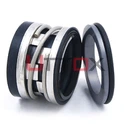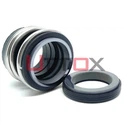When selecting mechanical seals for industrial applications, understanding temperature and pressure limits is crucial for ensuring optimal performance and longevity. Mech seal components operate under demanding conditions across various industries, from petroleum refining to water treatment facilities. The proper specification of these limits directly impacts seal reliability, maintenance costs, and overall system efficiency. Temperature extremes can cause material degradation, thermal expansion issues, and seal face distortion, while pressure variations affect the seal's ability to maintain proper contact and prevent leakage. This comprehensive guide explores the critical considerations for specifying mech seal temperature and pressure parameters, helping engineers make informed decisions that ensure reliable sealing performance in their specific applications.
Temperature Considerations for Mech Seal Performance
Material Selection Based on Operating Temperature
The foundation of proper mech seal specification begins with understanding how temperature affects seal materials. Different elastomers, face materials, and metal components respond uniquely to temperature variations, making material selection critical for successful operation. Fluorocarbon elastomers like Viton perform exceptionally well in high-temperature applications up to 400°F (204°C), while EPDM rubber works effectively in moderate temperature ranges but may degrade rapidly above 300°F (149°C). The mech seal face materials also require careful consideration, with silicon carbide and tungsten carbide offering superior performance at elevated temperatures compared to carbon-graphite alternatives. Metal components such as springs and hardware must maintain their mechanical properties throughout the operating temperature range, with Inconel and Hastelloy alloys providing excellent high-temperature stability. Understanding these material characteristics allows engineers to select mech seal components that will maintain their sealing integrity and mechanical properties throughout the intended operating temperature range, preventing premature failure and costly downtime.
Thermal Expansion and Seal Face Distortion
Temperature fluctuations create significant challenges for mech seal operation through thermal expansion and contraction effects. As temperatures rise, different materials expand at varying rates, potentially causing misalignment between seal faces and compromising the sealing interface. The coefficient of thermal expansion becomes a critical factor when specifying mech seal components, as mismatched expansion rates can lead to excessive face loading or loss of contact pressure. Seal face distortion occurs when uneven heating creates warpage or deflection in the sealing surfaces, resulting in increased leakage and accelerated wear. Modern mech seal designs incorporate features such as balanced configurations and specialized face geometries to minimize thermal distortion effects. Engineers must consider not only the steady-state operating temperature but also thermal cycling conditions, startup and shutdown procedures, and potential temperature spikes that could affect seal performance. Proper thermal management through cooling systems, heat exchangers, and insulation can help maintain mech seal components within their optimal temperature ranges.
Heat Generation and Dissipation Strategies
The friction generated between mech seal faces creates heat that must be effectively managed to prevent seal failure. Heat generation increases with face pressure, sliding speed, and surface roughness, making thermal management a critical aspect of seal specification. Inadequate heat dissipation can lead to thermal runaway conditions where increasing temperature causes further heat generation, ultimately resulting in seal failure. Mech seal designs incorporate various heat dissipation strategies, including enhanced circulation patterns, heat sinks, and external cooling systems. The selection of appropriate face materials becomes crucial for heat management, with materials like silicon carbide offering excellent thermal conductivity to distribute heat away from the sealing interface. Lubrication systems, whether external or provided by the process fluid, play a vital role in heat removal and temperature control. Engineers must evaluate the heat generation potential of their specific application and ensure that the mech seal design includes adequate provisions for thermal management to maintain safe operating temperatures.

Pressure Limits and Seal Design Considerations
Static and Dynamic Pressure Effects
Understanding the difference between static and dynamic pressure effects is essential for proper mech seal specification. Static pressure, the constant pressure exerted by the sealed fluid, affects the seal's ability to maintain proper face contact and prevent leakage. Dynamic pressure variations, including pressure spikes, pulsations, and transient conditions, create additional challenges for mech seal performance. The seal design must accommodate both steady-state pressure conditions and dynamic pressure fluctuations that occur during normal operation. Balanced mech seal designs help reduce the net closing force on the seal faces, allowing operation at higher pressures while maintaining reasonable face loads. The pressure rating of mech seal components depends on factors such as seal diameter, face material strength, and hardware design limitations. Engineers must consider not only the normal operating pressure but also maximum allowable working pressure, test pressure requirements, and potential overpressure conditions that could damage the seal. Proper pressure specification ensures that mech seal components can withstand the mechanical stresses imposed by the operating environment while maintaining effective sealing performance.
Pressure-Velocity Limitations
The relationship between pressure and velocity significantly impacts mech seal performance and longevity. Higher pressures generally require lower operating speeds to prevent excessive heat generation and maintain acceptable seal face wear rates. The PV factor, calculated as pressure multiplied by velocity, provides a useful guideline for evaluating mech seal operating limits. Different face material combinations have varying PV limits, with harder materials like tungsten carbide typically allowing higher PV values than softer alternatives. The mech seal design must also consider the effects of pressure on seal face deformation and contact stress distribution. As pressure increases, seal faces may deflect or deform, potentially affecting the sealing interface geometry and performance. Advanced seal designs incorporate features such as pressure balancing, face geometry optimization, and specialized support structures to manage high-pressure conditions effectively. Engineers must evaluate the combined effects of pressure and velocity in their specific application to ensure that mech seal components operate within acceptable limits and provide reliable long-term performance.
Pressure Balancing and Seal Configuration
Pressure balancing is a critical design consideration that affects both the pressure limits and performance characteristics of mech seal systems. Balanced seals reduce the net closing force on the seal faces by equalizing pressure on both sides of the sealing interface, allowing operation at higher pressures with reduced face loading. The balance ratio, typically ranging from 0.6 to 0.8 for most applications, determines the degree of pressure balancing and affects seal opening force, face pressure, and heat generation. Unbalanced mech seal designs may be suitable for lower pressure applications but become impractical at higher pressures due to excessive face loading and heat generation. The selection of appropriate seal configuration depends on the specific pressure requirements, with cartridge seals offering advantages in high-pressure applications through improved alignment and pressure distribution. Engineers must consider the pressure balancing requirements of their application and select mech seal designs that provide optimal performance while maintaining adequate safety margins. Proper pressure balancing ensures that seal faces maintain appropriate contact pressure throughout the operating range while preventing excessive loading that could lead to premature failure.
Environmental Factors Affecting Seal Limits
Chemical Compatibility and Corrosion Resistance
Chemical compatibility between the process fluid and mech seal materials is fundamental to successful seal operation. Aggressive chemicals can cause swelling, hardening, cracking, or dissolution of elastomeric components, while corrosive environments may attack metal hardware and face materials. The selection of appropriate mech seal materials requires comprehensive evaluation of chemical compatibility data, considering not only the primary process fluid but also cleaning agents, additives, and potential contamination sources. Temperature effects on chemical compatibility must also be considered, as elevated temperatures can accelerate chemical reactions and material degradation. Fluoropolymer elastomers and ceramic face materials often provide superior chemical resistance compared to conventional materials, but their selection must be balanced against other performance requirements. The mech seal design should incorporate corrosion-resistant materials and protective coatings where necessary to ensure long-term reliability in aggressive chemical environments. Engineers must thoroughly evaluate the chemical compatibility of all seal components to prevent premature failure and maintain sealing integrity throughout the service life.
Contamination and Abrasive Conditions
Contamination and abrasive particles in the process fluid significantly impact mech seal performance and operating limits. Solid particles can cause accelerated wear of seal faces, damage to secondary sealing elements, and interference with proper seal operation. The size, hardness, and concentration of contaminants determine their impact on seal performance, with fine abrasive particles often causing more severe wear than larger particles that may be excluded from the sealing interface. Mech seal designs for contaminated applications incorporate features such as hard face materials, specialized flushing systems, and barrier fluid arrangements to minimize contamination effects. The selection of appropriate face material combinations becomes critical in abrasive environments, with materials like tungsten carbide and silicon carbide offering superior wear resistance compared to softer alternatives. Proper filtration and flushing systems can help reduce contamination levels and extend seal life in challenging applications. Engineers must evaluate the contamination characteristics of their specific application and select mech seal designs that can tolerate the expected levels of particulate matter while maintaining acceptable performance and service life.
Atmospheric and Installation Conditions
Environmental conditions surrounding the mech seal installation can significantly affect performance and operating limits. Ambient temperature variations, humidity levels, and atmospheric contamination can impact seal operation and material properties. Outdoor installations may experience temperature cycling, UV exposure, and weather-related contamination that affects seal performance. The mech seal design must consider these environmental factors and incorporate appropriate protection measures such as weatherproof housings, UV-resistant materials, and thermal insulation. Installation conditions, including alignment accuracy, shaft deflection, and vibration levels, also affect seal performance and operating limits. Poor installation practices can reduce the effective operating limits of mech seal components and lead to premature failure. Proper installation procedures, including alignment verification, surface finish requirements, and torque specifications, are essential for achieving optimal seal performance. Engineers must consider both the process environment and installation conditions when specifying mech seal components to ensure reliable operation throughout the intended service life.
Conclusion
Proper specification of temperature and pressure limits for mech seal components requires comprehensive understanding of material properties, thermal effects, pressure dynamics, and environmental factors. The selection of appropriate seal designs, materials, and configurations directly impacts system reliability, maintenance costs, and operational efficiency. Engineers must evaluate all relevant operating conditions, including steady-state and transient conditions, to ensure that mech seal components operate within safe limits while providing optimal sealing performance throughout their service life.
Ready to optimize your mech seal selection for your specific application? At Uttox Fluid Technology, our experienced R&D team provides expert technical guidance backed by 30 years of industry experience. We offer customized solutions for diverse working conditions across petroleum refining, water treatment, and other demanding industries. With our rich product variety, sufficient inventory for fast delivery, and professional technical team providing free technical support, we're your reliable partner for mechanical sealing solutions. Our quality assurance through independent quality control ensures you receive superior products that meet your exact specifications. Contact us today at info@uttox.com to discuss your mech seal requirements and discover how our expertise can enhance your system performance!
References
1. Mayer, E. "Mechanical Seals: Selection and Application Guidelines for High Temperature and Pressure Services." Industrial Sealing Technology Handbook, 2019, pp. 145-167.
2. Thompson, R.K., and Peterson, J.L. "Temperature Effects on Mechanical Seal Face Materials: A Comprehensive Analysis." Journal of Sealing Technology, vol. 28, no. 4, 2020, pp. 312-328.
3. Williams, D.A. "Pressure Balancing in Mechanical Seals: Design Considerations and Performance Optimization." Mechanical Seal Engineering Quarterly, vol. 15, no. 2, 2021, pp. 89-104.
4. Anderson, M.P., et al. "Chemical Compatibility and Environmental Factors in Mechanical Seal Applications." Process Industry Sealing Standards, 2018, pp. 234-251.
5. Roberts, S.J. "Thermal Management in High-Performance Mechanical Seals." Advanced Sealing Technology Review, vol. 42, no. 3, 2019, pp. 178-195.
6. Chen, L.W., and Martinez, C.R. "Pressure-Velocity Relationships and Operating Limits for Industrial Mechanical Seals." International Conference on Fluid Sealing Technology Proceedings, 2020, pp. 456-472.







